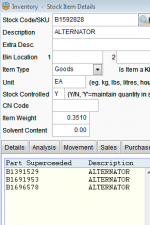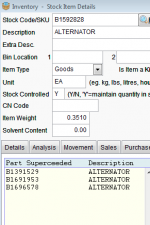You are using an out of date browser. It may not display this or other websites correctly.
You should upgrade or use an alternative browser.
You should upgrade or use an alternative browser.
DC Voltage Output
- Thread starter bartles
- Start date
More options
Export threadDo not use a ohm meter you must use a volt meter. Should be 12 volts or more up to 14 volts.Both AC & or DC output on mowers, can be measured with a OHM meter, while engine is running.
No matter what the amperage out put of the charging system the voltage output has to be more than a fully charged battery which is around 12.75 volts or over time the load on the battery would kill the battery since it would not be charging the battery.
If measuring the amps at the red cable connected to the battery, then the DC voltage will be greater than the battery voltage, or the amps could not be flowing. What the measured voltage might be will depend on the charged state of the battery. Of course in a "charging" state, one could not actually measure any difference between batter and rectifier output, allowing for any drop due to resistance of the wires.
Keep in mind that alternator is DC only and rated at 3 amps(2-4 on the wall chart). What makes it DC only is the fact they put a diode in series with the output wire which acts as a half-wave rectifier of the AC voltage being produced by the stator. They don't provide an AC voltage spec because the diode is encased in heat shrink tubing and there isn't a convenient way to get your voltmeter probe on the stator side of the diode(anode side). As others have indicated, the easiest way to check is simply measure the battery voltage with the engine off and then when it's running at wide open throttle(wot). If the latter is greater than the former by a volt or more(depending on the initial state of the battery), you can usually assume it's OK. You can see the 696578 alternator in the second row from the top on the attached chart.
Attachments
AtRo Racing
Forum Newbie
- Joined
- Sep 2, 2019
- Threads
- 0
- Messages
- 9
Working on a B&S Model 254707-0120-01. Is there a way to determine the DC output of the B&S alternator, part number 592828/ superseded Part number 391529?
AtRo Racing
Forum Newbie
- Joined
- Sep 2, 2019
- Threads
- 0
- Messages
- 9
The eady way js to useWorking on a B&S Model 254707-0120-01. Is there a way to determine the DC output of the B&S alternator, part number 592828/ superseded Part number 391529?
You can use a clip on amp meter attached to the positive battery cable. To test remove the fuse from the alternator and run the engine noting the amp and voltage draw. Shut the engine off and reinstall the fuse. Start the engine. If the amp meter is showing positive amps and the voltage has increased then all is well. The biggest issue wrh is fhe wire touches the flywheel causing the battery not to charge.Working on a B&S Model 254707-0120-01. Is there a way to determine the DC output of the B&S alternator, part number 592828/ superseded Part number 391529?
Robbie
Amps mean nothing in terms of DC voltage output. Unregulated AC output of any charging coil is 26 volts minimum. If you have that, check the DC voltage of the battery. If say, 12.7 volts, mower not running, check again at battery with mower running at high idle. At the battery should be a minimum of a .5 volt rise. So, 12.7 volts DC not running, should be 13.2 volts DC minimum, running at high idle. If that is the case, the battery would be charging.
OzPete
Member
- Joined
- Sep 3, 2019
- Threads
- 3
- Messages
- 13
Txmowman is correct. The STATOR (aka the Alternator), under the flywheel actually produces between 24 and about 28 VOLTS of ALTERNATING CURRENT (AC) Yes, AC !
It doesn’t matter whether it’s a 1-Wire Stator, or a 2-Wire Stator, it’s output voltage is tested at 3,600 RPM and the Multimeter has to be set to measure AC. On many multimeters the symbol on the dial looks like this .. V~.
This goes for nearly all “under flywheel” charging systems on mowers & motorbikes etc which have to charge 12V batteries. On Briggs systems they vary the maximum outputted charging CURRENT (Amps) possible by using different sized magnets within the flywheel itself.
The AC current produced by the flywheel’s magnets rotating around the Stator is transformed (Rectified) into DC (Direct Current) by the use of a Rectifier-Regulator.
Because it’s job is to maintain a 12V battery, the Rectifier-Regulator is designed to output somewhere between 13.9 to 14.5 DC volts, which should be measured at the battery’s positive terminal using a DC Voltmeter with the engine at 3,000 RPM Minimum.
It doesn’t matter whether it’s a 1-Wire Stator, or a 2-Wire Stator, it’s output voltage is tested at 3,600 RPM and the Multimeter has to be set to measure AC. On many multimeters the symbol on the dial looks like this .. V~.
This goes for nearly all “under flywheel” charging systems on mowers & motorbikes etc which have to charge 12V batteries. On Briggs systems they vary the maximum outputted charging CURRENT (Amps) possible by using different sized magnets within the flywheel itself.
The AC current produced by the flywheel’s magnets rotating around the Stator is transformed (Rectified) into DC (Direct Current) by the use of a Rectifier-Regulator.
Because it’s job is to maintain a 12V battery, the Rectifier-Regulator is designed to output somewhere between 13.9 to 14.5 DC volts, which should be measured at the battery’s positive terminal using a DC Voltmeter with the engine at 3,000 RPM Minimum.
- Joined
- Sep 24, 2017
- Threads
- 288
- Messages
- 6,901
The previous part number is, though. and it's a 3 amp.That part no. does not show in the Briggs alternator chart but that style stator produces between 2-4 amps.


